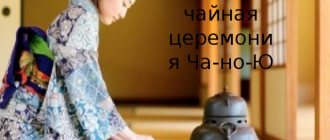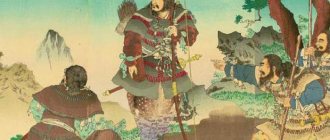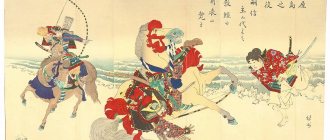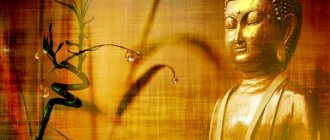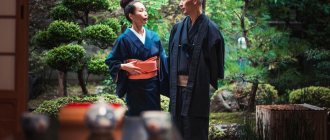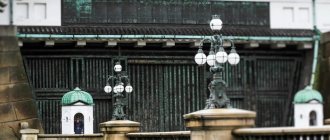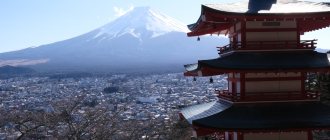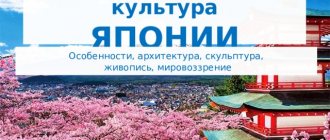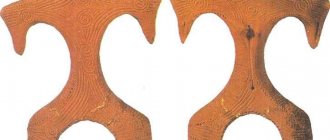Presentation “Artistic Culture of Japan”
Artistic culture of
JAPAN
Features, architecture, sculpture,
painting, worldview
world creation
(Master of the Center of Heaven), Takamimusubi and Kamimusubi. Together they began to weave the fabric of the universe and create our world. At the beginning of the universe, the inhabitants of the Land of the Rising Sun believe, the earth and sky were one. However, they then separated, marking the emergence of the High Sky Plain (高天原 - Takamagahara) and Akitsushima Island (蜻蛉島 or Dragonfly Island).
At the same time, three deities were born: Amenominakanushi (Master of the Center of Heaven), Takamimusubi and Kamimusubi. Together they began to weave the fabric of the universe and create our world. Then, in the middle of the big nothingness, there existed “Something” (Sora), something that could not be described.
From this arose another deity named Kunitokotachi no Mikoto (Deity of the Eternal Establishment of the Earth).
world creation
The awakening of this deity led to the appearance of other gods as well. Often asexual. Even later, divine pairs of brothers and sisters appeared, who personified the masculine and feminine principles. There were eight such pairs in total. The last couple to appear are the gods Izanagi (イザナギ) and Izanami (イザナミ). They are very important because they became the ancestors of people.
Architecture
In the architecture of Japan, borrowings from Chinese architecture are noticeable. Unlike Chinese buildings and those created in Japan under the influence of the Chinese style, typically Japanese buildings are characterized by asymmetry. In general, Japanese architecture is characterized by a desire for simplicity. The buildings are light and open, mainly consisting of rectangular elements.
For traditional Japanese architecture up to the Meiji period, wood was the main building material. The reasons for using wooden structures were affordability and ease of manufacture. In addition, wooden structures were better suited to the Japanese climate, allowed for natural ventilation of the premises, and also made it easy to move the structure by disassembling it and reassembling it in a new location.
Architecture
Traditional wooden residential houses of ordinary Japanese, called minka (Japanese: 民家), are maximally adapted to the country's climate. The one- or two-story minka has a strong frame structure of thick beams with a load-bearing column in the center of the house and sliding doors. The walls are not load-bearing; the interior space is divided into separate rooms using movable screens.
Peasants, artisans and traders lived in such houses. Currently, minkas are preserved only in rural areas.
Architecture
Famous temples
Tsurugaoka Hachimangu Shrine
Tsurugaoka Hachimangu Shrine is one of the main attractions in Kamakura. Surrounded by sakura trees and azalea thickets, it is very picturesque. The temple was built in 1063 by Yoritomo’s ancestor, Yoriyoshi, in honor of the god Hachiman, who was considered the patron saint of the Minamoto clan. Yoritomo in 1180 changed the location of the ancient temple, placing it in a more prominent place - the top of Tsurugaoka Hill (Crane Hill). The modern buildings date back to 1828.
The wide road leading from the seashore up to the temple was built by order of the shogun when he learned that his wife was expecting a child. And today this street retains the name Wakamiya Oji - Street of the Young Prince. Three huge torii gates were built along this alley, and cherry trees were planted along it.
Near the temple there are two ponds - Genji and Heike. White lotuses grow in the Genji pond, red lotuses in the Heike pond.
The so-called Drum Bridge is a humpback bridge across a lotus pond. There is a belief that if you can climb and walk across a slippery bridge without assistance, you will have a long life ahead of you. Near the temple, the alley is crossed by a 150-meter passage. Here Yoritomo's warriors practiced yabusame - archery from horseback. In April and September, you can witness festivals during which warriors dressed in Kamakura period attire shoot arrows while riding a galloping horse.
Architecture
Famous temples
Kiyomizu-dera
is a Buddhist temple built in 798
, located in the eastern part of the city of Kyoto.
Inside the structure there is a natural waterfall formed by a small river flowing down the hill. But not only “live”
water gives harmony to the temple. The building was built without a single nail, and one gets the impression that it is so light that it is about to rise into the air.
Local residents believe that if you jump from the roof of the temple, any wish will come true. However, guests of Kyoto do not risk making such a jump, because according to statistics, 15% of those who jump do not survive!
The temple grounds offer beautiful views of the sunset, and in the small craft shops nearby you can buy cute handmade souvenirs.
Architecture
Famous temples
Himeji Castle
is the clearest evidence of Japanese castle architecture.
It was erected during the feudal period as a defensive structure to protect against enemies. Over the course of several centuries, the castle was rebuilt several times and retains the features of various artistic styles.
By some miracle, the castle survived the bombing of World War II and was depicted in many films, including the James Bond
You Only Live Twice.
The snow-white color of the castle gives the impression of a bird taking flight, and this architectural monument is often called
the “white heron castle”.
Architecture
Famous temples
Kotoku-in
is a Buddhist temple famous for its huge statue of Amitabha Buddha located in an open area.
This Buddha is the most revered in Japan. The bronze statue rests on a pedestal over 13 meters high and weighs about 93 tons! According to scientists, the Buddha was made in 1252. The wooden temple in which the statue was originally installed was washed away by a tsunami in the 15th century.
Architecture
Famous temples
Todai-ji Temple
located in the town of Nara and is the crown of engineering!
It is the largest wooden structure in the world, and its interior is decorated with the largest bronze statue of Buddha. The temple is surrounded by beautiful gardens. The Kegon School of Buddhism is located here, and on the territory of the temple you can see many valuable historical and religious artifacts. Deer stroll peacefully through the gardens, which are revered as messengers of the Shinto gods.
Architecture
Famous temples
Kinkaku-ji, or Golden Pavilion
, located in Kyoto and is the most popular tourist attraction in Japan.
The temple was built for the aging Shogun Ashikada Yoshimitsu
at the end of the 14th century. Unfortunately, in 1950, the pavilion building was completely destroyed by fire, and a young monk died.
Five years later, the temple was restored and completely restored its historical appearance. The building and the surrounding nature are in harmony with each other. The pavilion is covered with a golden roof, which is reflected in the pond, and the pond is reflected in the shining sheets of the roof.
Architecture
New technologies have had a significant impact on Japanese architecture. The need to rebuild cities destroyed after World War II gave great impetus to the development of Japanese architecture. At the same time, the cities that were rebuilt were very different from the pre-war ones. As a result, during the Meiji era the adoption of Western construction technologies and materials, new structures made of steel and concrete were very different from traditional Japanese buildings.
Sculpture
Religious sculptures
Most of the inhabitants of the “land of the rising sun” adhere to Shinto religious beliefs. However, there are also many Buddhists here. Daibutsu - giant Buddha statues - are the pride and great value of Japanese culture. The oldest of the statues (7th century AD) - Daibutsu Asuka - is made unusually realistically. The facial features of the “enlightened one” are full of peace and great knowledge. The work makes a strong impression, despite the fact that it has been restored several times. The surprising thing is that this image of Buddha is completely non-canonical, its features look unusual.
Sculpture
Religious sculptures
Another, no less ancient statue (8th century AD) is located in the Todai-ji Temple in the city of Nara. This sculpture is almost 15 meters high and is made in the strict aesthetics of canonical sculpture. It is known that this sculpture was designed to protect people from natural disasters and epidemics that struck Japan in the mid-8th century. All the bronze produced in the country was used to cast the statue. And more than two million people were employed in the construction of the temple and the production of sculpture.
Sculpture
Religious sculptures
Daibutsu Ushiku is the largest Buddha statue in Japan. The total height of the sculpture, including the pedestal and lotus-shaped plinth, is 120 meters. The sculpture was installed in 1995 in the city of Ushiku, 50 kilometers from the Japanese capital. It took about six thousand bronze plates to create this masterpiece. And the length of the eye is 2.5 meters.
Sculpture
Netsuke
Small figures, designed to serve as a special keychain supporting a small box for small things that was carried with you (there are no pockets in a real kimono), are real works of art. Of all the types of netsuke, only a few can be considered sculptures - these are katabori (depictions of people and animals), anabori (multi-figure compositions carved as if between the valves of a shell), men (theater masks). In fact, today it is difficult to find real, antique netsuke; most often in souvenir shops you can only find plastic stamps. Although in many museums you can buy excellent copies of ancient netsuke for 35-40 dollars (the cost of a real collector's item can reach hundreds of thousands of dollars).
Sculpture
Okimono
Unlike netsuke, okimono is a carved figurine for decorating a table or interior. Subjects can be very different: images of Shinto gods, animals, vegetables and fruits. Each sculpture is made very delicately and elegantly. It is known that Gorky collected okimonos.
Painting
Large role in the development of Japanese painting
played a role in the spread of Buddhism in the country. The fact is that in order to initiate believers into the events of Buddhist sacred history, long scrolls called emakimono were created en masse, which depicted historical scenes and sketches from parables. Initially, these designs were very simple and rather symbolic in nature, but over time their quality has increased, and the best emakimono are very expressive.
Initially, Japanese artists were strongly influenced by China and painted in the kara-e style. But after a certain time, paintings in the Yamato-e style began to appear as a counterbalance to this style. In the 10th-12th centuries, it became dominant in painting, and only works of a religious nature continued to be painted in the Chinese style.
Painting
Portrait painting developed in the 11th-12th centuries, when many paintings that were perfect in execution technique appeared. Some of them were depicted on shutters. A little later, artists began to create emakimono in the Japanese style. The scrolls themselves were transformed: now they could contain secular motifs, depictions of historical events from the point of view of Buddhist morality. They were distinguished by amazingly high-quality detail work and bright colors.
Painting
Mural painting - paintings on screens - became the main forms of fine art from the end of the 16th century. Such works decorated temples, city houses and even the palaces of aristocrats.
Painting
Mural painting - paintings on screens - became the main forms of fine art from the end of the 16th century. Such works decorated temples, city houses and even the palaces of aristocrats.
Literature
The first Japanese work that has survived to this day is a chronicle called Kojiki. It was written by Yasumaro Ono in 712. The book contained various folklore, represented by songs, myths, fairy tales, legends, etc. In addition, the work also had historical value. Indeed, in the Kojiki the author left some historical legends and chronicles. Another example of ancient Japanese literature is Manyoshu. The book was a huge collection of lyrics, which included more than 4,000 folk and original tanka poems.
Initially, myths and songs were common in Japan, which were transmitted orally. However, closer to the 7th century, everything changed. Emperor Tenji established higher schools where Chinese was taught. Soon, the written Japanese language emerged by borrowing and optimizing characters from China. Thus, by the 7th century, writing began to actively spread. As a result, monuments of Japanese literature began to appear.
Another example of ancient Japanese literature is Manyoshu. The book was a huge collection of lyrics, which included more than 4,000 folk and original tanka poems.
Literature
The next stage of Japanese literature was called classical. It lasted from the 8th to the 12th centuries. Japanese literature was strongly intertwined with Chinese. Most of the Japanese people were illiterate. It was for this reason that Japanese fiction spread among the aristocracy and high court circles. Perhaps the main feature of this era is that most of the works were written by women. It is for this reason that family and other decent motives predominate in classical Japanese literature.
Literature
After the fall of the shoguns, the emperors returned to power. This led to the emergence of a new period in Japanese literature, which lasted until the mid-20th century. The land of the rising sun has become more open to another world. And this turned out to be the main factor for the development of literature. A characteristic feature of this period is the active influence of European ideas and trends.
First, the number of translations of European (including Russian) literature increased significantly. People wanted to learn about foreign culture. Later, the first Japanese works began to appear, written in a European style. For example, books such as “The Pillar of Fire,” “The Love Confession of Two Nuns,” and “The Five-Story Pagoda” are far removed from the Japanese classics. These works actively cultivated European ideology and lifestyle.
Literature
Japanese works of a lyrical nature deserve special attention. Japanese poetry, or haiku, has been popular throughout almost the entire period of literary development. The peculiarity of such works lies in the structure. According to the canons of the genre, haiku consist of 17 syllables, which form a column of hieroglyphs. The main theme of such works is a description of the beauty of nature or philosophical reflections. The most famous haijin are Takahama Kyoshi, Kobayashi Issa, Masaoka Shiki. Well, we can safely call Matsuo Basho the father of haiku.
Literature
There is such a moon in the sky, It’s like a tree cut down at the roots: The fresh cut is white. Willow is bent over and sleeping. And it seems to me that the nightingale on the branch is her soul. (c) Matsuo Basho
Farewell poems I wanted to write on the fan... It broke in my hand... Old pond. A frog jumped into the water. A splash in silence. The leaves have fallen. The whole world is one color. Only the wind hums. What sadness! A Captive Cricket is suspended in a small cage. The ground disappears from under your feet. I grab the light ear... The moment of separation has arrived..
Japanese writing
Modern Japanese uses three main writing systems: kanji - characters of Chinese origin and two-syllable alphabets created in Japan: hiragana and katakana. In Japan itself, this system is traditionally called “mixed writing with hieroglyphs and kana” (Japanese: 漢字仮名交じり文 kanji kana majiribun). Japanese text often contains Latin letters, used to write common abbreviations (for example, DVD or NATO) and other purposes. Transliteration of Japanese into Roman letters is called romaji and is rarely found in Japanese texts. Arabic numerals are often used to write numerals (usually in texts with a horizontal writing direction). The exclusion of any of the listed types of writing or the replacement of one with another in their accepted use makes the text difficult to read or incomprehensible at all (this, perhaps, does not apply to Latin letters, the role and use of which is currently much less in comparison with the three main systems) .
Japanese food
The most characteristic features of Japanese cuisine:
— Using mainly fresh products, always of high quality. Practically no shelf-stable products are used, with the exception of rice and sauces.
— A huge range of seafood used for cooking.
— The desire to preserve the original appearance and taste of the ingredients in the dish. This distinguishes Japanese cuisine from most Asian cuisines, where products are often changed beyond recognition during the cooking process.
— Seasonality of food.
- Small portions. The amount of food is gained through a greater variety of dishes, rather than portion sizes.
- Specific cutlery - most dishes should be eaten with chopsticks, some can be eaten with your hands, spoons are used extremely rarely, forks and knives are not used at all. For this reason, most dishes are served in small pieces that are easy to pick up with chopsticks and do not need to be divided.
— The principles of food presentation and serving are sharply different from European ones. Greater emphasis is placed on the aesthetic appearance of dishes and the table as a whole than in European cuisine.
— Specific table etiquette.
Japanese food
Seafood products are especially popular.
Seafood for such dishes is either not subjected to heat treatment at all, or such processing is kept to a minimum so as not to affect the natural taste of the ingredients.
Sushi
They are prepared from specially cooked rice and raw seafood. The form of sushi is very diverse; almost any seafood is used in preparation. There are two main types of sushi. The first is sushi itself (nigiri, tataki and some others), which is a small, elongated lump of rice, on top of which is laid a piece of fish or shrimp; Some types of such sushi are wrapped in a strip of seaweed, which together with the rice forms a container filled with finely chopped seafood, caviar or vegetables on top.
The second type is the so-called rolls, which differ in a fundamentally different method of preparation: rice and seafood are laid out in layers on a sheet of seaweed, rolled into a thin roll, which is then cut crosswise into small pieces with a sharp knife. There are other forms (see article). Sushi is served on a flat plate or wooden stand, with wasabi, soy sauce and pickled gari ginger.
Sashimi
Thinly cut slices of raw seafood, usually fish, octopus, squid, are served on a flat plate with fresh vegetables, such as thinly sliced daikon radishes and shiso leaves. Like sushi, served with wasabi and soy sauce.
